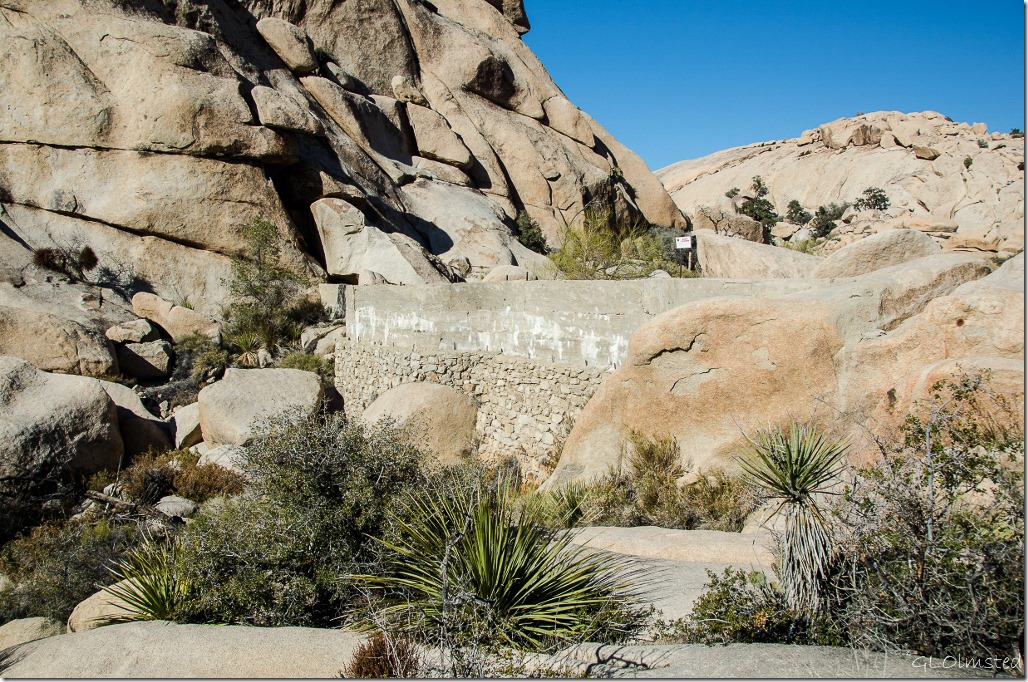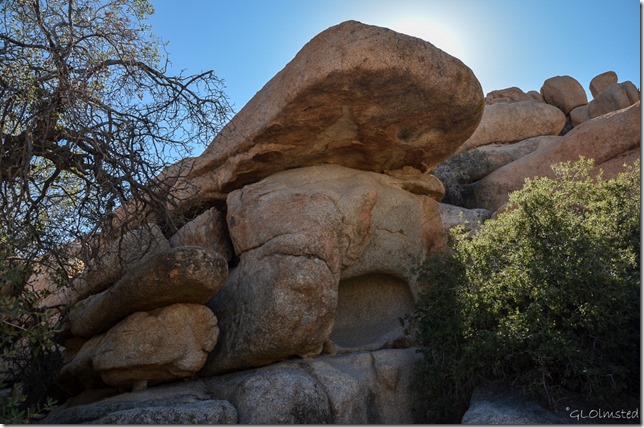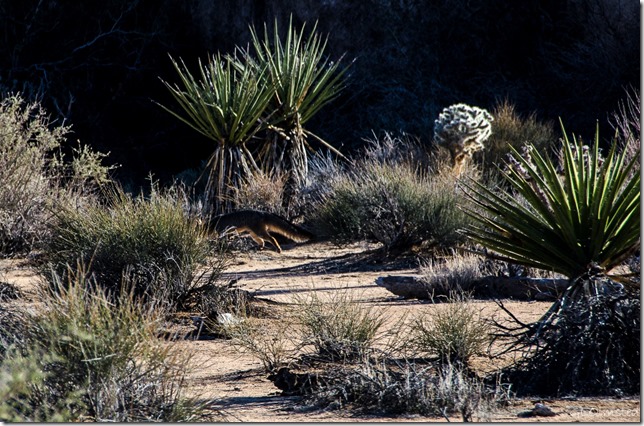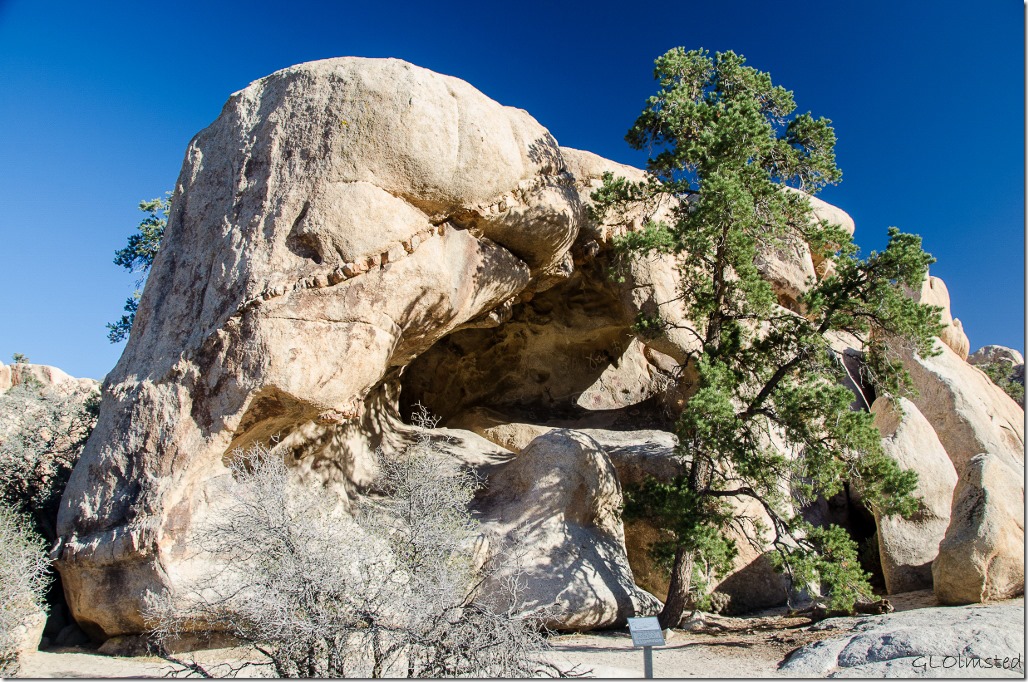Water brings life to the desert for the native plants, wildlife and people too. In fact only 100 years ago the arid landscape we now call Joshua Tree National Park saw more precipitation and the hidden springs of oasis filled with palms provided a perfect place to live. Plus miners and ranchers once built structures like Barker Dam to hold back the life giving water.
I hope you’re not tired of seeing the boulders in Joshua Tree because I did one more walk on my last full day in the park.
After Keys View looking down on the Coachella Valley full of the congestion of too much civilization in one place I really needed a nature fix. So after some lunch with temperatures rising enough to reduce one layer I headed for the nature walk on the Barker Dam trail.
 I never tire of seeing the boulders which look stacked by giants.
I never tire of seeing the boulders which look stacked by giants.
 They seem to call for rock climbing and although this one isn’t as big as some it may be a good way to learn without being so far from the ground.
They seem to call for rock climbing and although this one isn’t as big as some it may be a good way to learn without being so far from the ground.
 I figured with the recent rain Barker Dam would be full of water enticing some wildlife into the area. There were a a few puddles along the trail.
I figured with the recent rain Barker Dam would be full of water enticing some wildlife into the area. There were a a few puddles along the trail.
 Yet there was very little water behind the dam which looked more like a mud puddle. Notice the water lines on the surrounding rocks that tell a different story of water levels.
Yet there was very little water behind the dam which looked more like a mud puddle. Notice the water lines on the surrounding rocks that tell a different story of water levels.
 According to the interpretive signs, what started as a natural catch basin for rainfall and runoff was blocked by the Barker Dam, originally built by the Barker & Shay Cattle Company in 1902 when an average of 10 inches (.25 m) of annual rain fell here compared to the 2-5 inches (.05-.12 m) now. Grasses were lush for grazing.
According to the interpretive signs, what started as a natural catch basin for rainfall and runoff was blocked by the Barker Dam, originally built by the Barker & Shay Cattle Company in 1902 when an average of 10 inches (.25 m) of annual rain fell here compared to the 2-5 inches (.05-.12 m) now. Grasses were lush for grazing.
 Then between 1940-50, rancher Bill Keys and family added the upper concrete layer on top of the lower stone wall. I really wanted to take the Ranger-guided Keys Ranch tour to see and learn more about this hardy family that survived 60 years in this desert. Unfortunately, the first available reservations were for two weeks away.
Then between 1940-50, rancher Bill Keys and family added the upper concrete layer on top of the lower stone wall. I really wanted to take the Ranger-guided Keys Ranch tour to see and learn more about this hardy family that survived 60 years in this desert. Unfortunately, the first available reservations were for two weeks away.
 Over the years of low water many have left their mark on the accessible dam wall. What is wrong with people who feel the need to mar our park’s natural or cultural history? Does it become part of the story?
Over the years of low water many have left their mark on the accessible dam wall. What is wrong with people who feel the need to mar our park’s natural or cultural history? Does it become part of the story?
 At its maximum the water encompasses about 20 acres (8 ha) with a pipeline carrying water to the cattle trough in the wash behind the dam. Non-native plants like willows were planted to provide shade for the cattle and in wet years cattails can be seen. Whatever little moisture is here attracts many animals and birds. Coots and grebes are known to nest here and migrating herons stop by.
At its maximum the water encompasses about 20 acres (8 ha) with a pipeline carrying water to the cattle trough in the wash behind the dam. Non-native plants like willows were planted to provide shade for the cattle and in wet years cattails can be seen. Whatever little moisture is here attracts many animals and birds. Coots and grebes are known to nest here and migrating herons stop by.
 Unfortunately my mid-day walk meant most smart desert dwellers were hiding in the shade.
Unfortunately my mid-day walk meant most smart desert dwellers were hiding in the shade.
 I continued walking the loop, up, over and around the boulders, occasionally seeking a shady rest. I certainly wasn’t tired, yet I wanted to be in touch with the rock, to listen to their stories.
I continued walking the loop, up, over and around the boulders, occasionally seeking a shady rest. I certainly wasn’t tired, yet I wanted to be in touch with the rock, to listen to their stories.
 Gray fox slips through the brush
Gray fox slips through the brush
Then I moved on, like the miners, ranchers and visitors before me while the true Mojave desert survivors remain, adjusting to diminishing water. Times will change again for us humans and we would be wise to learn from other life how to adapt.
 People before us, bands of the Chemehuevi, Serrano, and Cahuilla Indians, laid out their trails between water holes, gathered plants for food and textiles, and left their marks behind.
People before us, bands of the Chemehuevi, Serrano, and Cahuilla Indians, laid out their trails between water holes, gathered plants for food and textiles, and left their marks behind.
 Sadly the rock art has been defaced. Rumor has it that decades ago a film company painted these so they could be seen more clearly. Presumably we didn’t know any better then. Ahem.
Sadly the rock art has been defaced. Rumor has it that decades ago a film company painted these so they could be seen more clearly. Presumably we didn’t know any better then. Ahem.
 This easy 1.3 mile (2 km) loop past Barker Dam with a few short rock scrambles took me a couple of lollygag hours as I paused to look at the way life survives in this arid environment even with the occasional help of water. And speaking of water, I carried two liters finishing both even on a cool spring afternoon. Think about the dry excessive heat of a summer walk and be prepared.
This easy 1.3 mile (2 km) loop past Barker Dam with a few short rock scrambles took me a couple of lollygag hours as I paused to look at the way life survives in this arid environment even with the occasional help of water. And speaking of water, I carried two liters finishing both even on a cool spring afternoon. Think about the dry excessive heat of a summer walk and be prepared.







